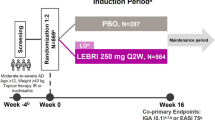Abstract
Allergic rhinitis (AR) is a common and chronic health problem with a high prevalence and a significant effect on the health care expenditure. Intranasal steroid spray is recommended as the first line therapy for patients with moderate to severe AR. Our study clinically analysed the use of nasal breathing exercise (NBE) as an adjunct to intranasal steroid spray as a cheap and effective mode of management of AR. A 3 month, parallel, randomized study was carried out in a zonal and tertiary care referral center. In this study, participants (N = 60) with symptomatic AR were administered either a intranasal steroid spray fluticasone propionate (group A) or fluticasone propionate nasal spray and NBE (group B). Participants assessed their symptom severity daily over the 3 month treatment period. The mean total nasal symptom scores were lower in both the groups (5.1 vs. 3.8333 for group A and 5.2 vs. 2.6777 for group B) and the difference was statistically significant (P < 0.05). The patients showed a definite improvement in overall and individual symptoms for both groups with significantly greater reduction in individual symptoms in the group B (P < 0.05). In our study we have found that both treatments provided clinically meaningful responses, but the overall results favored fluticasone propionate and the NBE group. Hence NBE is a simple and cost effective measure to reduce symptoms of AR and improve patient satisfaction.

Similar content being viewed by others
References
Bousquet J, Khaltaev N, Cruz AA, Denburg J, Fokkens WJ, Togias A et al (2008) Allergic rhinitis and its impact on asthma (ARIA) 2008 update (in collaboration with the World Health Organization, GA(2)LEN and AllerGen). Allergy 63(Suppl 86):8–160
Canonica GW, Bousquet J, Mullol J, Scadding GK, Virchow JCA (2007) Survey of the burden of allergic rhinitis in Europe. Allergy 62(Suppl 85):17–25
Crystal-Peters J, Crown WH, Goetzel RZ, Schutt DC (2000) The cost of productivity losses associated with allergic rhinitis. Am J Manag Care 6:373–378
van Oene CM, van Reij EJ, Sprangers MA, Fokkens WJ (2007) Quality assessment of disease-specific quality of life questionnaires for rhinitis and rhinosinusitis: a systematic review. Allergy 62(12):1359–1371
Upton MN, McConnachie A, McSharry C, Hart CL, Smith GD, Gillis CR, Watt GCM (2000) Intergenerational 20 year trends in the prevalence of asthma and hay fever in adults: the midspan family study surveys of parents and offspring. Br Med J 321(7253):88–92
Yáñez A, Rodrigo GJ (2002) Intranasal corticosteroids versus topical H1 receptor antagonists for the treatment of allergic rhinitis: a systematic review with metaanalysis. Ann Allergy Asthma Immunol 89:479–484
Chan KO, Huang ZL, Wang DY (2003) Acoustic rhinometric assessment of nasal obstruction after treatment with fluticasone propionate in patients with perennial rhinitis. Auris Nasus Larynx 30(4):379–383
Martin BG, Andrews CP, van Bavel JH, Hampel FC, Klein KC, Prillaman BA, Faris MA, Philpot EE (2006) Comparison of fluticasone propionate aqueous nasal spray and oral montelukast for the treatment of seasonal allergic rhinitis symptoms. Ann Allergy Asthma Immunol 96(6):851–857
DeWester J, Philpot EE, Westlund RE, Cook CK, Rickard KA (2003) The efficacy of intranasal fluticasone propionate in the relief of ocular symptoms associated with seasonal allergic rhinitis. Allergy Asthma Proc 24(5):331–337
Featherstone C, Godden D, Gault C, Emslie M, Took-Zozaya M (2003) Prevalence study of concurrent use of complementary and alternative medicine in patients attending primary care services in Scotland. Am J Public Health 93:1080–1082
Djupesland PG, Chatkin JM, Qian W, Haight JS (2001) Nitric oxide in the nasal airway: a new dimension in otorhinolaryngology. Am J Otolaryngol 22:19–32
Lundberg JON, Farkas-Szallasi T, Weitzberg E (1995) High nitric oxide production in human paranasal sinuses. Nat Med 1:370–373
Maniscalco M, Weitzberg E, Sundberg J, Sofia M, Lundberg JO (2002) Assessment of nasal and sinus nitric oxide output using single-breath humming exhalations. Eur Respir J 22:323–329
Weitzberg E, Lundberg JO (2002) Humming greatly increases nasal nitric oxide. Am J Respir Crit Care Med 166:144–145
Maniscalco M, Sofia M, Weitzberg E, De Laurentis G, Stanziola A, Rosillo V (2004) Humming induced release of nasal nitric oxide for assessment of sinus obstruction in allergic rhinitis; pilot study. Eur J Clin Invest 34(8):555–560
Conflict of Interest
None.
Financial Support
None.
Author information
Authors and Affiliations
Corresponding author
Rights and permissions
About this article
Cite this article
Nair, S. Nasal Breathing Exercise and its Effect on Symptoms of Allergic Rhinitis. Indian J Otolaryngol Head Neck Surg 64, 172–176 (2012). https://doi.org/10.1007/s12070-011-0243-5
Received:
Accepted:
Published:
Issue Date:
DOI: https://doi.org/10.1007/s12070-011-0243-5




